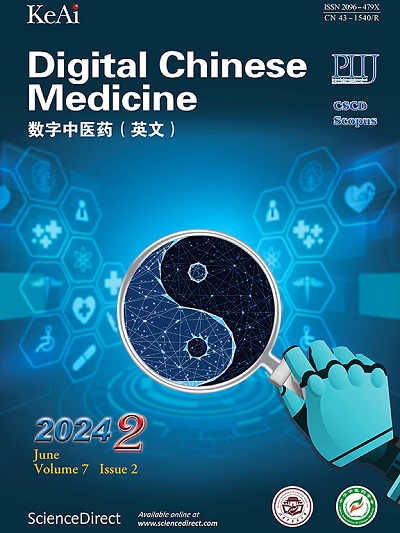Integrated plasma and synovial membrane lipidomic profiling revealing the therapeutic effects of moxibustion in collagen-induced arthritis rat models
Q3 Medicine
引用次数: 0
Abstract
Objective
To reveal the therapeutic effects of moxibustion in collagen-induced arthritis (CIA) rat models using the combined analysis of plasma and synovial membrane lipidomic profiling and to enhance the understanding of how moxibustion affects lipid metabolism in rheumatoid arthritis (RA).
Methods
A total of 32 male Sprague-Dawley (SD) rats were randomly assigned to four groups: control, moxibustion control (MC), model, and moxibustion model (MM) groups, with 8 rats in each group. CIA was induced in SD rats by two immunizations. The paw volume was measured before the induction of CIA. Following induction, after assessing paw volume and arthritis index (AI) scores, the MC and MM groups received treatment at bilateral Shenshu (BL23) and Zusanli (ST36) acupoints for 10 min per acupoint. The intervention included three treatment courses, each spanning 6 d and followed by a 1-d interval. Paw volume and AI scores were assessed after each treatment course. After the completion of the three treatment courses, serum, plasma, synovial tissue, and ankle joint samples were collected. Enzyme-linked immunosorbent assay (ELISA) was employed to quantify the levels of interleukin (IL)-6 and tumor necrosis factor (TNF)-α in serum. Hematoxylin and eosin (HE) staining was performed for histopathological examination of the ankle joint tissues. Meanwhile, ultra-high-performance liquid chromatography coupled with Q-Exactive Orbitrap mass spectrometry (UHPLC-Q-Exactive Orbitrap MS) was utilized to analyze the plasma and synovial tissue samples. In addition, multivariate statistical analysis was performed to identify differential lipid metabolites, and Kyoto Encyclopedia of Genes and Genomes (KEGG) pathway enrichment analysis was applied to explore metabolic pathways modulated by moxibustion therapy.
Results
No significant difference in hind paw volume and AI scores was observed among the groups (P > 0.05). After CIA induction, model group showed increased hind paw volume and AI scores compared with control group (P < 0.05), which were significantly reduced after moxibustion treatment in MM group compared with model group (P < 0.05). The levels of IL-6 and TNF-α were significantly higher in model and MM groups compared with control group (P < 0.05), but were lower in MM group than those in model group (P < 0.05). Histopathological analysis showed improved cartilage and reduced inflammation in MM group. A total of 33 differential lipid metabolites in the plasma and 24 in the synovial membranes of CIA rat models were identified when compared with control group. Among these lipid metabolites, 31 in the plasma and all 24 in the synovial membranes were regulated by moxibustion treatment. Pathological analysis revealed upregulation of diacylglycerol (DG) and fatty acid (FA) levels, alongside downregulation of lysophosphatidylcholine (LPC), phosphatidylcholine (PC), and phosphatidylethanolamine (PE). Under physiological conditions, the treatment specifically reduced LPC and PC levels. Pathway enrichment analysis revealed that moxibustion predominantly affected α-linolenic acid, glycerophospholipid, and sphingolipid metabolism under pathological conditions. Under physiological conditions, the regulation was centered around α-linolenic acid and glycerophospholipid metabolism.
Conclusion
The RA rat models exhibited significant lipid metabolic disturbances. Moxibustion alleviated paw swelling, reduced AI scores, modulated inflammatory cytokine levels, and partially corrected the altered levels of multiple lipid metabolites. The potential metabolic pathways implicated in the regulation of lipid metabolism under both physiological and pathological conditions include α-linolenic acid, glycerophospholipid, and sphingolipid metabolism.
血浆和滑膜脂质组学分析揭示艾灸对胶原性关节炎大鼠模型的治疗作用
目的通过血浆和滑膜脂质组学分析,探讨艾灸对类风湿关节炎(RA)大鼠模型的治疗作用,进一步了解艾灸对类风湿关节炎(RA)脂质代谢的影响。方法将32只雄性SD大鼠随机分为对照组、艾灸对照组、模型组和艾灸模型组,每组8只。SD大鼠通过两次免疫诱导CIA。CIA诱导前测定大鼠爪体积。诱导后,评估足爪体积和关节炎指数(AI)评分后,MC组和MM组分别在双侧肾俞穴(BL23)和足三里穴(ST36)治疗,每个穴治疗10 min。干预包括三个疗程,每个疗程跨越6天,随后是1天的间隔。每个疗程结束后评估爪体积和人工智能评分。三个疗程结束后,采集血清、血浆、滑膜组织及踝关节标本。采用酶联免疫吸附法(ELISA)测定血清中白细胞介素(IL)-6和肿瘤坏死因子(TNF)-α的水平。采用苏木精伊红(HE)染色对踝关节组织进行组织病理学检查。同时,采用超高效液相色谱-Q-Exactive Orbitrap质谱联用(UHPLC-Q-Exactive Orbitrap MS)对血浆和滑膜组织样品进行分析。此外,采用多变量统计分析鉴定差异脂质代谢物,并采用京都基因基因组百科全书(KEGG)途径富集分析探索艾灸疗法调节的代谢途径。结果各组大鼠后爪体积、AI评分差异无统计学意义(P >;0.05)。CIA诱导后,模型组大鼠后爪体积和AI评分均较对照组增加(P <;0.05),灸疗后MM组与模型组比较差异有统计学意义(P <;0.05)。模型组和MM组大鼠血清IL-6、TNF-α水平均显著高于对照组(P <;0.05), MM组低于模型组(P <;0.05)。组织病理学分析显示,MM组软骨改善,炎症减轻。与对照组相比,CIA大鼠模型血浆中鉴定出33种不同的脂质代谢物,滑膜中鉴定出24种不同的脂质代谢物。其中,血浆中的31种脂质代谢物和滑膜中的24种脂质代谢物均受艾灸治疗的调节。病理分析显示二酰基甘油(DG)和脂肪酸(FA)水平上调,同时溶磷脂酰胆碱(LPC)、磷脂酰胆碱(PC)和磷脂酰乙醇胺(PE)水平下调。生理条件下,处理能显著降低LPC和PC水平。途径富集分析显示,在病理条件下,艾灸主要影响α-亚麻酸、甘油磷脂和鞘脂代谢。生理条件下,调节主要围绕α-亚麻酸和甘油磷脂代谢进行。结论RA大鼠模型存在明显的脂质代谢紊乱。艾灸可减轻足跖肿胀,降低AI评分,调节炎症细胞因子水平,部分纠正多种脂质代谢物水平的改变。在生理和病理条件下,参与脂质代谢调节的潜在代谢途径包括α-亚麻酸、甘油磷脂和鞘脂代谢。
本文章由计算机程序翻译,如有差异,请以英文原文为准。
求助全文
约1分钟内获得全文
求助全文
来源期刊

Digital Chinese Medicine
Medicine-Complementary and Alternative Medicine
CiteScore
1.80
自引率
0.00%
发文量
126
审稿时长
63 days
期刊介绍:
 求助内容:
求助内容: 应助结果提醒方式:
应助结果提醒方式:


